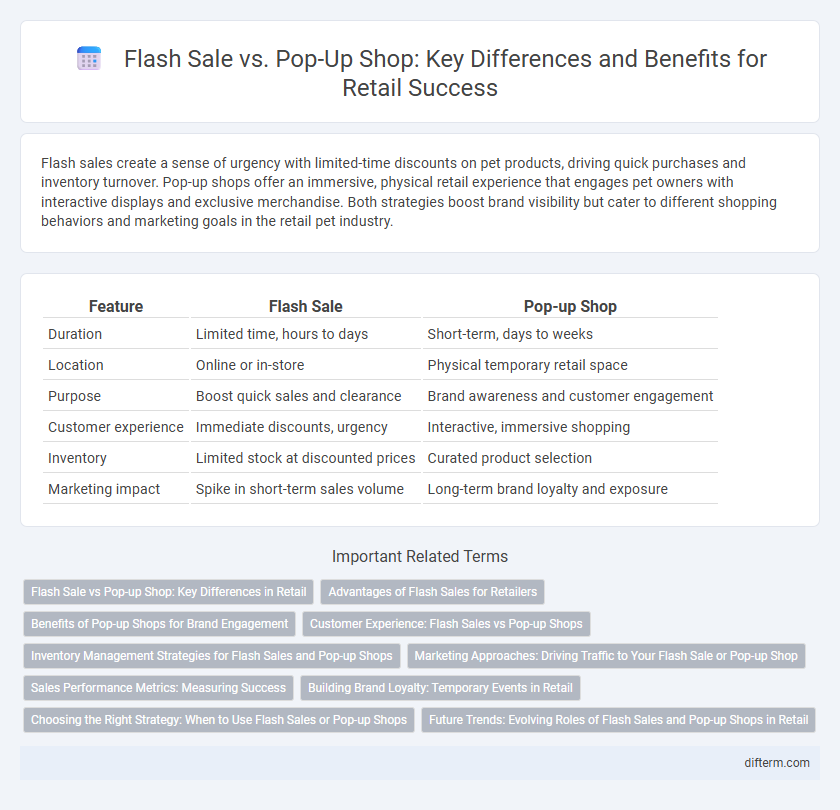Flash sales create a sense of urgency with limited-time discounts on pet products, driving quick purchases and inventory turnover. Pop-up shops offer an immersive, physical retail experience that engages pet owners with interactive displays and exclusive merchandise. Both strategies boost brand visibility but cater to different shopping behaviors and marketing goals in the retail pet industry.
Table of Comparison
| Feature | Flash Sale | Pop-up Shop |
|---|---|---|
| Duration | Limited time, hours to days | Short-term, days to weeks |
| Location | Online or in-store | Physical temporary retail space |
| Purpose | Boost quick sales and clearance | Brand awareness and customer engagement |
| Customer experience | Immediate discounts, urgency | Interactive, immersive shopping |
| Inventory | Limited stock at discounted prices | Curated product selection |
| Marketing impact | Spike in short-term sales volume | Long-term brand loyalty and exposure |
Flash Sale vs Pop-up Shop: Key Differences in Retail
Flash sales create urgency by offering limited-time, deeply discounted products online or in-store, driving immediate consumer purchases and inventory turnover. Pop-up shops establish temporary physical locations to enhance brand visibility, provide immersive customer experiences, and test markets without long-term commitments. While flash sales emphasize rapid sales volume, pop-up shops focus on brand engagement and local market presence.
Advantages of Flash Sales for Retailers
Flash sales boost retailer revenue by creating urgency and driving rapid purchase decisions, leading to immediate cash flow improvements. These time-limited promotions effectively clear excess inventory, reducing storage costs and freeing up stock for new products. Retailers benefit from increased online traffic and enhanced brand visibility, attracting new customers through targeted digital marketing campaigns.
Benefits of Pop-up Shops for Brand Engagement
Pop-up shops create immersive, temporary retail environments that boost brand engagement by offering exclusive, hands-on experiences that foster emotional connections with customers. These short-term spaces allow brands to test new markets, gather immediate customer feedback, and generate buzz through social media sharing. Enhanced by personalized interactions and limited-time product availability, pop-up shops drive brand awareness and strengthen loyalty more effectively than traditional flash sales.
Customer Experience: Flash Sales vs Pop-up Shops
Flash sales create a sense of urgency with limited-time offers, driving immediate purchases but often resulting in a high-pressure shopping environment. Pop-up shops enhance customer experience by providing immersive, brand-focused interactions and personalized service, fostering stronger emotional connections. While flash sales boost short-term sales volume, pop-up shops build lasting brand loyalty through experiential retail.
Inventory Management Strategies for Flash Sales and Pop-up Shops
Flash sales require highly efficient inventory management strategies centered on rapid stock turnover and real-time inventory tracking to avoid stockouts and overselling. Pop-up shops benefit from flexible inventory allocation, often leveraging localized stock that can be replenished based on demand patterns and customer engagement. Both retail models optimize inventory through predictive analytics and integrated supply chain systems to balance availability with cost control.
Marketing Approaches: Driving Traffic to Your Flash Sale or Pop-up Shop
Flash sales leverage urgency and time-sensitive discounts to drive rapid customer traffic, utilizing email blasts, social media countdowns, and push notifications for immediate engagement. Pop-up shops focus on experiential marketing by creating immersive, localized brand environments that attract foot traffic through in-person events, influencer partnerships, and geo-targeted advertising. Both strategies optimize consumer interactions, with flash sales maximizing online urgency and pop-up shops building tangible brand experiences to boost footfall and conversion rates.
Sales Performance Metrics: Measuring Success
Flash sales generate rapid spikes in revenue through limited-time discounts, measurable by conversion rates, average order value, and units sold per hour. Pop-up shops, however, enhance brand engagement and customer experience, with success tracked via foot traffic, transaction volume, and repeat visit frequency. Comparing sales performance metrics reveals flash sales excel in immediate turnover, while pop-up shops drive long-term customer loyalty and higher lifetime value.
Building Brand Loyalty: Temporary Events in Retail
Flash sales create urgency by offering limited-time discounts that encourage immediate purchases, reinforcing brand excitement and repeat engagement. Pop-up shops provide immersive brand experiences in unique locations, fostering personal connections and enhancing customer loyalty. Both temporary events leverage exclusivity and novelty to strengthen customer relationships and drive long-term brand commitment.
Choosing the Right Strategy: When to Use Flash Sales or Pop-up Shops
Flash sales drive rapid sales spikes and clear inventory quickly, ideal for time-sensitive promotions or seasonal stock. Pop-up shops focus on brand experience and local engagement, perfect for testing new markets or launching exclusive products. Retailers should analyze customer behavior, inventory levels, and marketing goals to determine whether immediacy or long-term brand building fits their strategy best.
Future Trends: Evolving Roles of Flash Sales and Pop-up Shops in Retail
Flash sales will increasingly leverage AI-driven personalization and real-time inventory data to create urgency and boost conversions, while pop-up shops are set to become experiential hubs integrating augmented reality and localized marketing to enhance customer engagement. The fusion of digital and physical retail channels will redefine these formats, with flash sales providing instant gratification online and pop-up shops offering immersive brand experiences offline. Retailers adopting hybrid models that combine the immediacy of flash sales with the tactile appeal of pop-up shops will lead future trends in consumer interaction and sales optimization.
Flash Sale vs Pop-up Shop Infographic

 difterm.com
difterm.com